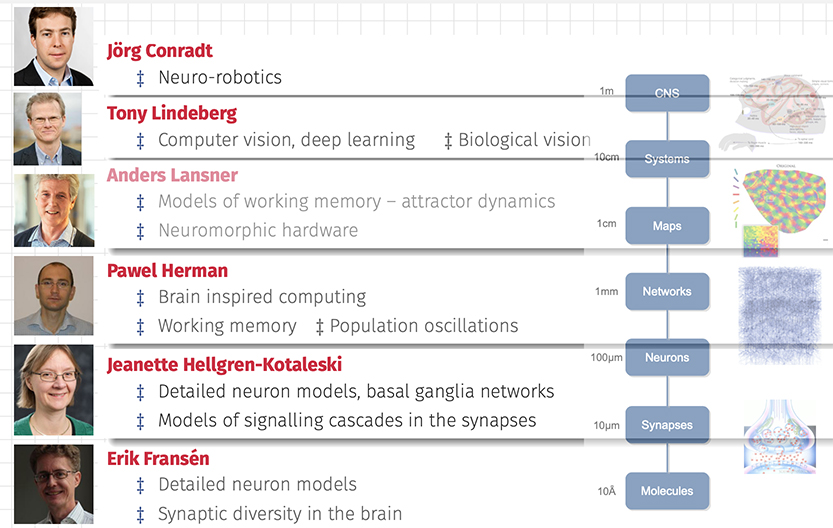Computational Brain Science
The scientific mission of the Computational Brain Science Lab at EECS is to be at the forefront of mathematical modelling, quantitative analysis and mechanistic understanding of brain function. We perform research on (i) computational modelling of biological brain function and on (ii) developing theory, algorithms and software for building computer systems that can perform brain-like functions. Our research answers scientific questions and develops methods in these fields. We integrate results from our science-driven brain research into our work on brain-like algorithms and likewise use theoretical results about artificial brain-like functions as hypotheses for biological brain research.
Mathematical modelling of brain function and dysfunction
Our research on biological brain function includes sensory perception (vision, hearing, olfaction, pain), cognition (action selection, memory, learning) and motor control at different levels of biological detail (molecular, cellular, network) and mathematical/functional description.
We develop methods for investigating biological brain function and its dynamics as well as dysfunction, biomechanical simulation engines for locomotion and voice, machine learning methods for analysing functional brain images and neuronal multi-scale simulations.
Brain-like computing
Our research on brain-like computing concerns the development of methods and algorithms for perceptual systems that extract information from sensory signals (images, video and audio), analysis of functional brain images and EEG data, learning for autonomous agents as well as the development of computational architectures (both software and hardware) for neural information processing. Our brain-inspired approach to computing also applies more generically to other computer science problems such as pattern recognition, data analysis and intelligent systems.
Long term vision
Our long term vision is to contribute to (i) a deeper understanding of the computational mechanisms underlying biological brain function and (ii) better theories, methods and algorithms for perceptual and intelligent systems that perform artificial brain-like functions by (iii) performing interdisciplinary and cross-fertilizing research on both biological and artificial brain-like functions.
On one hand, biological brains provide existence proofs for guiding our research on artificial perceptual and intelligent systems. On the other hand, applying Richard Feynman’s famous statement ”What I cannot create I do not understand” to brain science implies that we can only claim to fully understand the computational mechanisms underlying biological brain function if we can build and implement corresponding computational mechanisms on a computerized system that performs similar brain-like functions.
Researchers

The research at the Computational Brain Science Lab is mainly performed within the following areas under the supervision of eight principal investigators (listed alphabetically).
Jörg Conradt: neurorobotics, neuromorphic systems, control of neuro-prostheses, engineering applications of neural computation, event-based vision algorithms and systems, brain-inspired closed-loop control for autonomous mobile robotics
Örjan Ekeberg: neuro-mechanical simulation, computational neuroscience, neuroinformatics, neural information processing, neurorobotics, biomechanical models, locomotion, animal motor control, voice production, closed loop neural control
Erik Fransén: computational neuroscience, computational pharmacology, pain, epilepsy, working memory, intrinsic excitability, dendritic integration, ion channel kinetics, ion channel modulation, entorhinal cortex, hippocampus, C-fiber, peripheral nerve
Jeanette Hellgren-Kotaleski: computational neuroscience, computational systems biology, kinetic modeling, basal ganglia, reward dependent learning, neuroinformatics, multi-scale approaches
Pawel Herman: neuroinformatics, computational neuroscience, cortical modelling, associative memory, cortical dynamics and oscillations, brain data analysis, connectionist systems, brain-inspired computing, data mining, brain-computer interface
Arvind Kumar: controllability of neuronal networks, network of networks, spiking neuron network dynamics, correlations, synchrony and oscillations, information flow in neuronal networks, cortico-basal ganglia interactions, neuromodulation, epilepsy, Parkinson's disease, dynamics of brain diseases
Anders Lansner: supercomputational neuroscience, neuromorphic systems, neural network models, cortex, cortical associative memory, basal ganglia, reward learning, early olfactory and visual processing, temporal sequence learning, closed loop neural control
Tony Lindeberg: vision, computer vision, scale-space theory, visual and auditory receptive fields, feature detection, image descriptors, object recognition, video analysis, computational modelling of visual and auditory perception, normative theory for neural mechanisms
Projects
Current
Covariant and invariant deep networks
Funded by the Swedish Research Council 2023-2026
Previous projects
HBP, The Human Brain Project,
Neurorobotics sub-project SP10
Funded by European Commission as a FET flagship, 2016-2020
Integrating new experimental findings into a novel Hebbian plasticity theory of working memory and neural binding
Funded by The Swedish Research Council 2019-2022
Scale-space theory for covariant and invariant visual perception
Funded by The Swedish Research Council 2019-2022
How does neuronal diversity affect the dynamics and function of networks in the brain
Funded by The Swedish Research Council 2019-2022
Scale-space theory for invariant and covariant visual receptive fields
Funded by The Swedish Research Council, 2015-2018
Time-causal receptive fields for computer vision and computational modelling of biological vision
Funded by Stiftelsen Olle Engkvist Byggmästare, 2016-2017
Brain-inspired computing approach to exploratory analysis of multivariate spatiotemporal brain signals for non-invasive diagnostic evaluation.
Funded by Vinnova via Stockholm Brain Institute, 2014-2016
Brain-like algorithms for temporal sequence processing - recognition, generation, and learning
Funded by Swedish Science Council, 2012-2016
StratNeuro – Strategic Research Area Neuroscience, assistant professor position in computational neuroscience.
Governmental funding via Swedish Science Council, 2010-2016
HBP, The Human Brain Project,
Neuromorphic computing sub-project SP9
Funded by European Commission as a FET flagship, 2013-2016
BrainScaleS – Brain-inspired multiscale computation in neuromorphic hybrid systems
Funded by European Commision FET-Proactive FP7, 2011-2015
Funded by European Commision, Erasmus Mundus, 2010-2015
Idealized computational models of auditory receptive fields
CSC Small Visionary Project, 2013-2014
Image descriptors and scale-space theory for spatial and spatio-temporal recognition
Funded by The Swedish Research Council, 2011-2014

